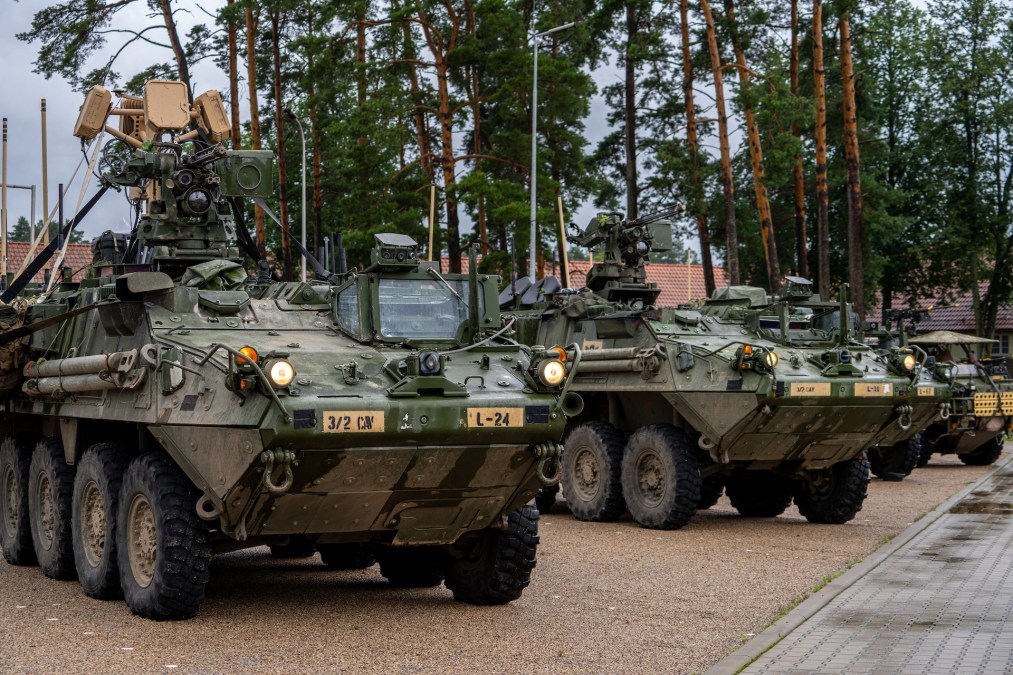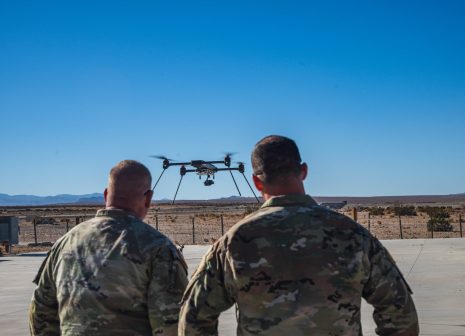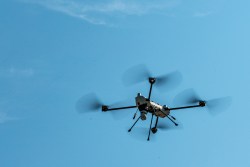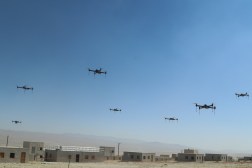Army moving forward with ‘sled’ concept for maneuver air defense against drones, other aircraft

Army leadership has signed off on a capabilities development document for a future increment of the Maneuver-Short Range Air Defense (M-SHORAD) capability, including a “sled” concept to give the service more flexibility.
The document was recently approved by Chief of Staff Gen. Randy George.
The move comes as the Army is trying to address a wide range of airborne threats, including swarms of small drones in the Group 1 and Group 2 categories of unmanned aerial systems; Group 3 UAS, such as the types of one-way attack drones that have proliferated in the Ukraine-Russia war; larger drones in the Group 4 and Group 5 UAS categories; and other aircraft.
“What we’re calling it is M-SHORAD Inc. 4 … and really what we’re trying to do with this requirements document is really converge the best of breed from our counter-UAS and our M-SHORAD capabilities that we’ve fielded over the past 10 or so years,” said Col. Marc Pelini, military deputy for the fires future capability directorate at Army Transformation and Training Command.
That directorate is responsible for concepts, experimentation and requirements for the Army’s fires portfolio.
“We’ve learned a lot as you look at the Stout vehicle — which is the Stryker-based M-SHORAD platform — and you look at what we’re doing with the M-LIDS [Mobile Low, Slow Unmanned Aircraft Integrated Defense System] capability and the counter-UAS side, what we’re trying to do is identify the best-of-breed capabilities to address the full spectrum of threats from Group 1 [drones] all the way up through fixed-wing aircraft. So the approach that we’re taking for it is we’re moving away from a fully integrated vehicle, and what we’re pursuing is a ‘sled’ concept. So think of like a pallet or a sled that I could put in the back of any vehicle — whether it’s an ISV, a Humvee, a JLTV, or even a technical vehicle like a Toyota truck — and I can have that self-contained capability that allows the maneuver commander to have a menu of options,” Pelini said during a panel at the annual AUSA conference Monday.
“And when I talk about menu of options, I’m talking about being able to pull off a radar like an X-band radar and put a Ku-band radar on, or pull a Coyote [interceptor] pod off and put a Stinger pod on — and the system itself, or the pallet itself, recognizes that and automatically changes the user interface for the operator to engage those threats. So the way that we’re taking that is through an open hardware and software really kind of a plug-and-play approach to it. So open APIs, so people can integrate into the platform itself relatively easy and we’re not having to spend time … to reintegrate the pallet as more and more capabilities come online,” he added.
Officials are also looking for “unit and soldier common” capabilities that are intuitive and lessen the cognitive burden on warfighters.
“And then, as we look at the various capabilities that are out there, from a sensing perspective, you have acoustic sensors, you have bistatic sensors, you have active radar, you have EO/IR cameras. So coming up with a way that we can fuse those at the platform and at the tactical edge, and then eventually bring that up into the cloud, where we can do fusion across the entirety of the [area of responsibility],” Pelini explained.
The Army wants systems that are low-cost and scalable, so they can acquire them in large quantities and also avoid situations where warfighters are launching $30,000 weapons at $300 drones, he noted.
Air defenders may face additional challenges when operating in the homeland, such as the need to avoid fratricide or unintended damage. That’s why the Army is interested in so-called “low collateral defeat” technologies.
“What we’re trying to do, at least in the homeland, is identify capabilities that if I shoot a drone down or bring a drone down, it doesn’t cause collateral effects on the ground and harm innocent bystanders. So this, generally speaking, [is] where we’re going with the requirements,” Pelini said.
Army officials want to explore M-SHORAD Increment 4 technology via Project Flytrap, which includes exercises designed test new counter-drone technologies, with the aim of incorporating them into formations down the line.
“Our intent is to have a prototype by Flytrap 5.0, which is a [U.S. European Command] combined exercise between the U.S. and our U.K. counterparts, in the March-April timeframe. So the chief really challenged us to go fast on this. We believe that we have a lot of the components out there. There’s a lot of great capabilities out there that we believe we can integrate onto the platform,” Pelini told DefenseScoop.
Lessons learned from Flytrap will inform the M-SHORAD Increment 4 program, noted Col. Guy Yelverton, deputy for acquisition and systems management and counter-small UAS project lead at program executive office for missiles and space.
“We’re going to take that learning, roll it back into the program, and then move forward as fast as we can to start to provide that first initial capability to the air defense community as quickly as possible. Within a year after that, would be my boss’s goal [for fielding the tech], because that’ll drive me to go faster than I think I can go. So, speed is our number one desire these days, is to move out on these projects and provide capability through the transformation-in-contact concept to get that out there soon,” Yelverton told DefenseScoop.






